Arctic Ice Part 2: A Review of Factors Contributing to the Recent Decline in Arctic Ice
Posted on 5 July 2010 by Peter Hogarth
In Part 1, (also summarized here) we established that Arctic Ice extent, thickness and estimated volume have been diminishing over the past few decades and over the past century Comiso 2010. Perennial ice has reduced to a fraction of former levels and loss continues. Over the same period, the Arctic has warmed faster than any other region on Earth.
It is intuitive that short term variations in air and water temperature, cloud cover, weather patterns and currents will affect rate and timing of each summer melt and winter re-freeze. Long term trends in any of these factors could contribute to ice loss. As globally interlinked circulations of atmosphere and oceans act to transport and re-distribute thermal energy from tropical and subtropical regions towards the poles, it is likely that the Arctic region will also be sensitive to changes in these complex processes as well as lower latitude temperature changes Hurrell and Deser 2009, Hoerling 2004. We will attempt to explore Arctic climate trends in this review, looking at recent scientific papers and presentations, and concentrating on regional data, but mindful of these interactions with the wider global system.
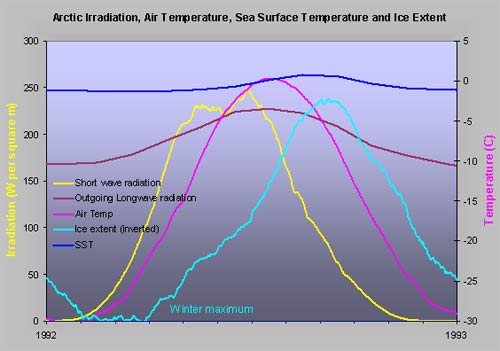
Timing of Arctic Sunlight, Long wave radiation, Sea Surface Temperature, Arctic air temperature and Ice extent (scale inverted): Note Summer air temperatures are currently constrained to just above melting point. data sources NSIDC, NOAA ESRL, DMI, NCDC. Some series smoothed for clarity.
We will start with the most comprehensive study (441 surface stations) of Arctic air temperatures to date. This shows an overall warming trend of 1.36 degrees C per century from 1875 to 2008 and a recently accelerated warming rate of 1.35°C per decade Bekryaev 2010. In line with other findings these high latitude increases are roughly twice the global average. We also have almost thirty years of polar orbiting satellite data from AVHRR, SSMR and SSM/I sensors which show that the increases in average surface air temperature correlate with reductions in sea ice extent, both temporally and spatially Comiso 2006. What is the cause of this temperature rise?
Shortwave radiation (sunlight) reaching the surface in the Arctic varies from a high Summer peak in June, to zero in Winter. Because of the lack of Winter sunlight, the Arctic radiation budget is dominated by longwave (infra red or heat) radiation flux through all seasons except Summer. What about trends? Long term changes in regional (and global) summer shortwave radiation at the surface have shown an overall downward trend (dimming) since the 1950s with a recent upturn after around 1980. This variation appears to mirror Sulphate aerosol pollution levels Wild 2009. Meanwhile, over the same period, outgoing and downwelling longwave radiation have steadily increased (NCEP reanalysis 60N to 90N) in line with regional warming.
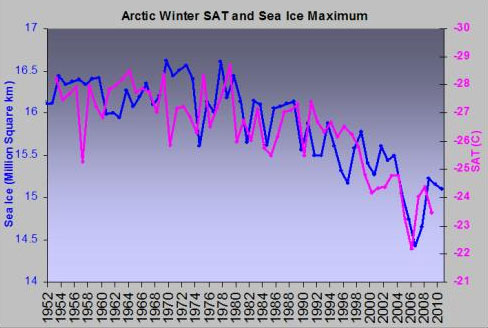
Surface air temperature averaged for October to February compared with March maximum ice extent since 1953. Data HadISST, NSIDC, and NCEP.
Downwelling long wave radiation will increase if cloud cover increases. Over the past thirty years trends of cloud cover in Summer and Autumn have been small Schweiger 2008, but there has been a significant decreasing (-5% per decade) trend in Arctic cloud cover in Winter Liu 2007, and an opposite increasing trend in Spring Francis 2007a. The extra cloud cover in Spring and increased downwelling longwave flux anomalies correlate with atmospheric warming and subsequent Summer ice extent changes in the six peripheral Arctic seas – explaining a proportion (around 40%) of ice extent variation Francis 2005.
Ice extent is also likely to be influenced by dynamic factors such as movement of warm Graverson 2010 (or cold) air masses caused by pressure gradients, and wind strength and direction - affecting movement of ice or surface waters (most prominently the “trans polar drift” and Beaufort gyre). Arbitrary indices of Northern high latitude atmospheric patterns Golubeva 2009, Wu 2010 such as the North Atlantic Oscillation Strong 2010, the related annular Arctic Oscillation Ohashi 2010, Ogi 2010a, the Pacific-North American pattern L’Heureux 2008, and the recently prevalent Arctic Dipole pattern Wu 2006, Wang 2009, have been correlated to varying degrees with variations in Arctic ice extent. When looking over multidecadal periods the correlations weaken, as sea ice has continued to decline throughout regimes of positive and negative atmospheric patterns Cohen 2005, Overland 2005, Maslanik 2007a, Deser 2008, but some statistically significant links remain Strong 2009. Indeed year on year variations in wind speed correlate well with ice extent changes Ogi 2010b, but what about the longer term?
Over the past thirty years there has been a rise in frequency of Arctic storms Simmonds 2008, and polewards movement of storm tracks, linked to Northward creep of isotherms in warming waters of the Atlantic Hakkinen 2009. However average Arctic wind speeds have shown no long term increase, in fact while Arctic ice has diminished most rapidly (over the past 15 years) there has been a fall in average wind speeds, associated with a corresponding decrease in Arctic Oscillation anomaly Weiss 2009.
Against this background average ice drift speeds have increased by around 8.5 % per decade in Summer and by 17% per decade in Winter over the past 32 years Weiss 2009, and maximum (storm driven) ice drift speeds have increased by a factor of around three over a 56 year period Hakkinen 2008; these are very significant increases.
Francis 2007 show that the extent of thin mobile winter ice in the Barents sea and particularly the Bering sea is sensitive to atmospheric circulations, so we might expect that as a greater proportion of the ice in the main Arctic Ocean ends up younger, thinner and less consolidated Maslanik 2007b, it is also more likely to be affected by wind Meier 2010. Rampal 2009 links increased ice drift rate with a positive feedback due to ongoing melt, leading to increases in ice strain rate, deformation, fracturing, lead opening, and decreasing albedo, which accelerates sea ice thinning in summer and delays refreezing in early winter. This further reduces the strength of the ice cover and allows even more deformation Wu 2010. A weaker ice cover can also more readily fracture and break free from the North Canadian coast, allowing very large scale sea ice motion, re-distributing previously stable accumulations of older thicker ice into areas where they will be more vulnerable to break up and loss through the melt season. Shimada 2008. The dynamic nature of these processes can be seen in the following animation of AMSR-E 89GHz data, and in the updated University of Colorado animation showing formation, motion, and reducing areas of multi-year ice.
Animation of AMSR-E 89GHz brightness data showing detailed distribution of Arctic ice, patterns of ice loss, and effects of circulations on ice extent and ice break up, and diminishing ice extent over recent decade. Thanks and credit to Koji Shimada (and also Eddy Carmack)
Updated animation of Arctic Ice showing distribution and motion of first year and older ice through the seasons from 1982 though to beginning of April 2010. This clearly shows increased loss of older thicker ice and both dynamic and in situ melt patterns. Credit and thanks to Jim Fowler and Chuck Maslanik, University of Colorado.
As drift rates increase, we might also expect a higher probability of additional wind driven ice loss through the various channels leading out of the Arctic Ocean Tsukernik 2009. The main channels of the Fram Strait, (between Greenland and Spitzbergen), and Bering Strait (between Siberia and Alaska), are wide enough to permit significant amounts of ice to be transported out of the Arctic Ocean each year. However independent studies show no significant trends in export of either area or estimated volumes of ice over recent decades, Wu 2006, Inoue 2007, Smedsrud 2008, Spreen 2009. How is this reconciled? Measurements of the ice thickness in this area suggest that the increasing rates of ice drift are effectively compensated by trends of thinner and less concentrated ice Kwok 2009.
We have seen that trends in radiative forcing, cloud cover, warming air temperatures, modulated by and air and ice movement are contributors to ice loss, Barreira and Scambos 2010, but there is another major factor. As well as outflow of ice, the Fram and Bering Straits also allow inflow of warmer Pacific and Atlantic waters Maslowski 2010. The Arctic ice is a thin floating layer. If we compare bottom ice melt with surface melt, we see any influx of thermal energy carried by relatively warm water may contribute significantly to overall ice melt and dominate in areas near the inflow Perovich 2010. Observed multidecadal increases in heat content of the upper layers of the Northern Atlantic and Pacific Palmer 2010 and any regional trends of increased Sea Surface Temperatures Andronache 2009, Steele 2008, Deser 2010 and changes in water movement would be expected to give context to this.
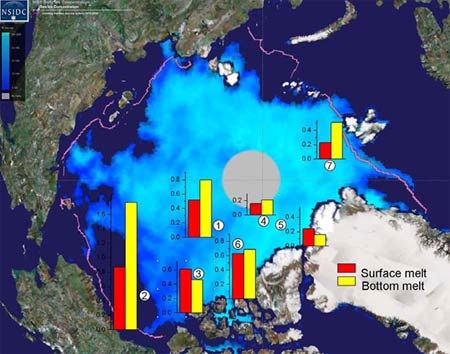
Averaged measurements of surface and basal ice melt from sonar buoys. From Perovich 2010, image courtesy of NSIDC
In the North Atlantic, Ivchenko 2009, Lozier 2008, Polyakov 2010 there has been an overall general warming trend in the upper 2000m of water over at least the last 80 years of the twentieth century, with strong multidecadal variations superimposed on this trend in the upper layers. Currents of warmer waters affect coastal Greenland Hannah 2009, Di Iorio 2009, Straneo 2010, Rignot 2010 and flow into the Arctic Ocean through the Fram Strait (the West Spitzbergen Current) Piechura and Walczowski 2009, Fieg 2010, Aksenov 2009, Schauer 2009 Jahn 2010. In the relatively shallow Barents Sea Levitus 2009, increase of inflowing oceanic heat causes the ice extent boundary to move Northwards, which causes more atmospheric exchange of heat energy over open waters (which in turn acts to limit sea temperatures and moderate further local ice retreat) Strong 2010, Smedsrud 2010.
Similarly in the North Pacific Dushaw 2009 overall longer term and significant recent warming has also occurred Kawano 2010, Douglass 2010. There are correlations between Pacific circulation patterns and summer water temperature trends Wendler 2009, heat influx through the Bering Strait has increased Mizobata 2010 and the inflow of warmer Pacific water matches recent patterns of major ice reduction in the Chukchi Sea and Beaufort Sea North of Alaska Shimada 2006. Here there has certainly been a dramatic increase in area of open water in Summer and this has allowed large additional Oceanic heat gain through solar warming Perovich 2007 in the Summer and delayed release of some of this heat through Autumn and into the winter Shaw 2009. This positive feedback process Hoerling 2009 is believed to be one of the primary causes of the enhanced polar surface warming or “Arctic Amplification” Serreze 2009, Matsoukas 2010, Screen and Simmons 2010, Miller 2010. As a result, average Northern Hemispheric zonal (latitudinal) temperature gradients have decreased, and the regulating role of the Arctic Ice is being diminished.
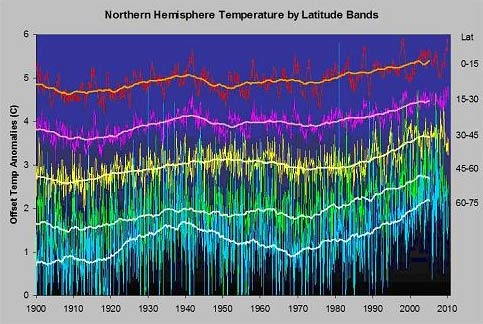
Combined land and sea temperature anomalies and 10 year averages for Northern Hemisphere separated into 15 degree latitude bands - offset by 1 degree C for clarity. In reality the tropics are around 30 degrees C warmer than the pole. The strong multidecadal variation at high latitudes is noteworthy. Data CRUTEM3 +HadSST2.
We now have an emerging but coherent picture of an increasingly vulnerable Arctic Ice cover warmed by a combination of regional factors and redistribution of global heat energy Northwards by transport of air and water from lower latitudes. Though most annual melt occurs due to localized thermodynamic processes within the confines of the Arctic Ocean, these are modulated by dynamic factors, which are themselves ultimately driven by larger scale thermodynamic processes. Declining Arctic ice is thus a very visible symptom of wider global warming, which like the thermal contribution to rising sea levels Marcelja 2010 offers independent evidence of long term increasing global heat content.
There is a mounting weight of evidence that this background warming trend has a strengthening link to increasing greenhouse gas emissions Gillet 2008. Johannessen 2008 suggests 90% of the decreasing sea-ice extent is empirically “accounted for” by the increasing anthropogenic CO2 in the atmosphere, and a great deal of recent modeling work indicates or assumes a strong link Zhang 2010. There is also other evidence of anthropogenic influence on the Arctic climate from transported aerosols such as black carbon, which may exceed Methane in importance in the Arctic due to the (short lived) impact on ice and snow albedo Faluvegi 2009, Quinn 2009, Koch 2009, Huang 2010 and other pollutants, which affect cloud thermal emissivity Tietze 2010. Instrumental and ice core records show substantial decreases in sulphates and especially Black Carbon aerosols since the 1980s.
Looking at the longer term larger picture, none of the factors examined here are truly independent of wider climate change or temperature rise. Arctic air temperature and Ocean temperature are driven by not only regional, - but through teleconnections and coupled atmospheric and oceanic transport mechanisms, global radiative forcings. Therefore it is likely that ongoing greenhouse gas driven increases in global heat content and transport will increasingly affect the Arctic climate, and based on current trends we run risks of losing the significant regulatory effect of the permanent Arctic Ice, with negative repercussions for the cold productive Arctic waters and regional ecology MacDonald 2010. Given that this process is already underway, we may well be witnessing the start of what in geological timescales would be viewed as a step function increase in atmospheric CO2, ice loss, freshwater release McPhee 2009, and permafrost melt, leading to an impulsive release of significant reservoirs of stored methane, all in a period covering a mere handful of human generations.































 Arguments
Arguments























 0
0  0
0
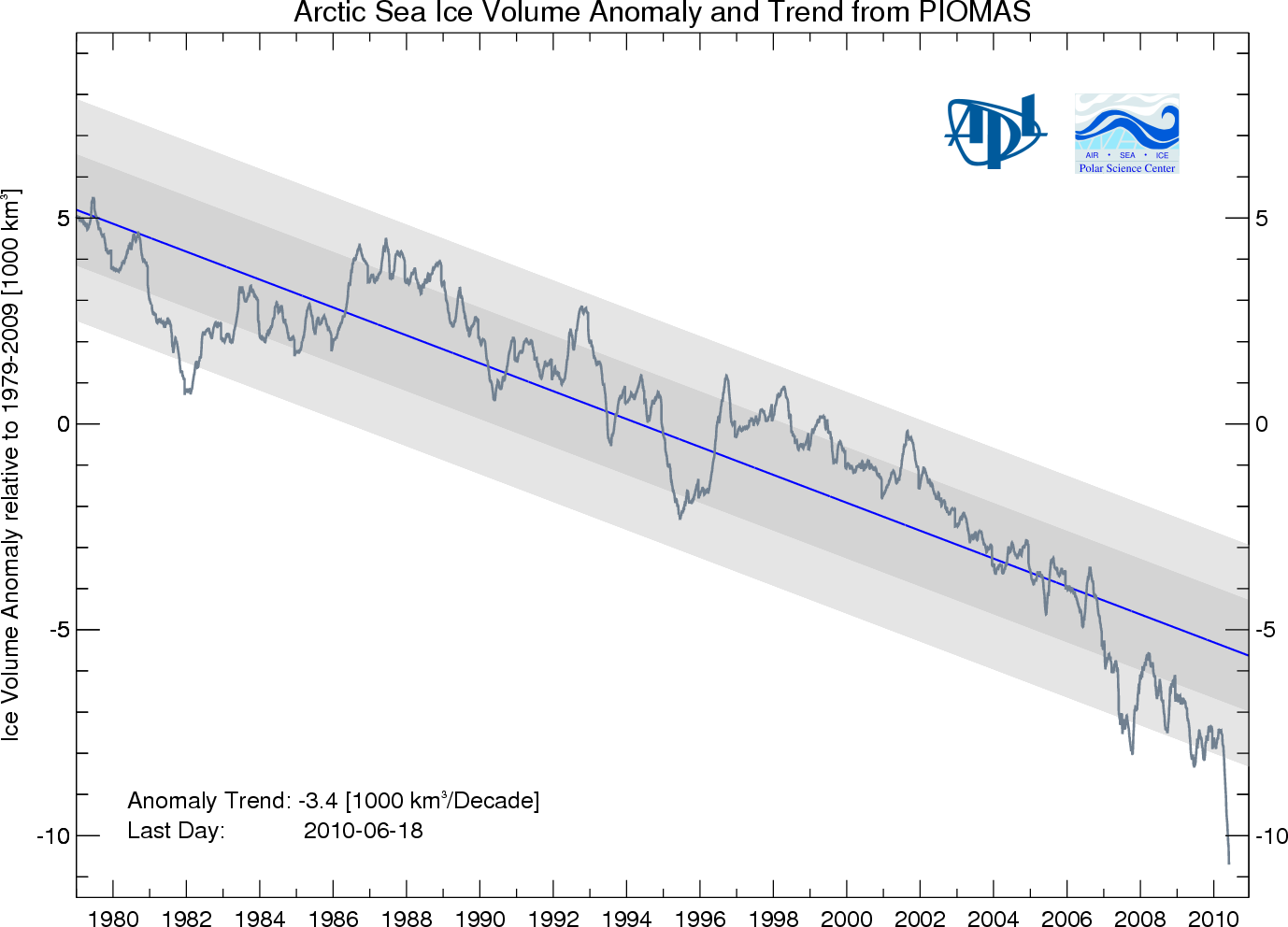 Note the overall downward trend (no "recovery") and the recent "death spiral".
Also it would behoove you to read this post.
And you may want to let Goddard know that PIPS 3.0 has some nicer animations available for next time.
The Yooper
Note the overall downward trend (no "recovery") and the recent "death spiral".
Also it would behoove you to read this post.
And you may want to let Goddard know that PIPS 3.0 has some nicer animations available for next time.
The Yooper







Comments